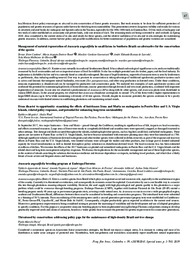Threatened by conservation: addressing policy gaps for the maintenance of high-density Brazil nut tree clumps.
Threatened by conservation: addressing policy gaps for the maintenance of high-density Brazil nut tree clumps.
Autoria: PAIVA, P. M. V. de
Resumo: Considered a cornerstone species in Amazonian forest conservation strategies, the Brazil nut enjoys a unique status. It is immune to cutting and most of its distribution is under some category of protected area. Nonetheless, both nut-gatherers and researchers consistently report insufficient natural regeneration levels and the population decline of high-density stands, including at strict nature reserves. The initial hypothesis of seed overharvesting lacks consensus as later studies identified the scarcity of canopy gaps at mature forests as the main cause for the recruitment failure of this gap-loving species. This observation supports the anthropogenic origin hypothesis and is consistent with the abundant recruitment observed in traditional swiddens, where the regeneration density increases with the number of cultivation cycles. This is due to a number of factors, including the scatterhoarder habit of the natural disperser, gap-clearance frequency, species? resistance to fire and remarkable re-sprouting capability. Nut-gatherers intuitively understand the role of swiddens for the maintenance and expansion of high-density Brazil nut stands, and many voluntarily protect their spontaneously enriched fallows from further cultivation cycles. Surprisingly, the very conservation policies end up hindering such traditional management practices. For example, when forbidding nutgatherers/swidden-farmers from clearing new plots of forest in exchange for those fallows they chose to protect. Expensive, labor-intensive and unpopular recommendations like enrichment planting are puny alternatives for what the ubiquitous swiddens can do, provided revised policies allow them to. Failing that, densities of senescent Brazil nut stands will continue to decrease until hardly justifying the ?sustainable alternative to deforestation? discourse.
Ano de publicação: 2019
Tipo de publicação: Resumo em anais e proceedings
Unidade: Embrapa Amapa
Palavras-chave: Castanha, Regeneração Natural
Observações
1 - Por padrão são exibidas publicações dos últimos 20 anos. Para encontrar publicações mais antigas, configure o filtro ano de publicação, colocando o ano a partir do qual você deseja encontrar publicações. O filtro está na coluna da esquerda na busca acima.
2 - Para ler algumas publicações da Embrapa (apenas as que estão em formato ePub), é necessário ter, no celular ou computador, um desses softwares gratuitos. Sistemas Android: Google Play Livros; IOS: iBooks; Windows e Linux: software Calibre.
Acesse outras publicações
Acesse a Base de Dados da Pesquisa Agropecuária (BDPA) para consultar o acervo completo das bibliotecas da Embrapa.

